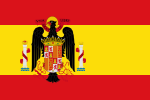Francoist Spain (Spanish: España franquista), or the Francoist dictatorship (dictadura franquista), was the period of Spanish history between 1939 and 1975, when Francisco Franco ruled Spain after the Spanish Civil War with the title Caudillo. After his death in 1975, Spain became a democracy. During this time period, Spain was officially known as the Spanish State (Estado Español).
The nature of the regime evolved and changed during its existence. Months after the start of the Spanish Civil War in July 1936, Franco emerged as the dominant rebel military leader and was proclaimed head of state on 1 October 1936, ruling a dictatorship over the territory controlled by the Nationalist faction. The 1937 Unification Decree, which merged all parties supporting the rebel side, led to Nationalist Spain becoming a single-party regime under the FET y de las JONS. The end of the war in 1939 brought the extension of the Franco rule to the whole country and the exile of Republican institutions. The Francoist dictatorship originally took a form described as "fascistized dictatorship", or "semi-fascist regime", showing clear influence of fascism in fields such as labor relations, the autarkic economic policy, aesthetics, and the single-party system. As time went on, the regime opened up and became closer to developmental dictatorships, although it always preserved residual fascist elements.During the Second World War, war-ravaged and starving Spain did not join the Axis powers (its supporters from the civil war, Italy and Germany) but supported them in various ways throughout most of the war while maintaining its neutrality as an official policy of "non-belligerence". Because of this, Spain was isolated by many other countries for nearly a decade after World War II, while its autarkic economy, still trying to recover from the civil war, suffered from chronic depression. The 1947 Law of Succession made Spain a de jure kingdom again, but defined Franco as the head of state for life with the power to choose the person to become King of Spain and his successor.
Reforms were implemented in the 1950s and Spain abandoned autarky, reassigning economic authority from the Falangist movement, which had been prone to isolationism, to a new breed of economists, the technocrats of Opus Dei. This led to massive economic growth, second only to Japan, that lasted until the mid-1970s, known as the "Spanish miracle". During the 1950s, the regime also changed from being openly totalitarian and using severe repression to an authoritarian system with limited pluralism. As a result of these reforms, Spain was allowed to join the United Nations in 1955, and during the Cold War, Franco was one of Europe's foremost anti-communist figures: his regime was assisted by Western powers, particularly the United States. Franco died in 1975 at the age of 82. He restored the monarchy before his death and made his successor King Juan Carlos I, who would lead the Spanish transition to democracy.











